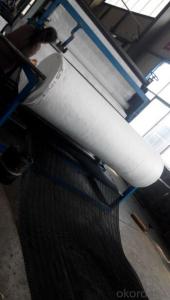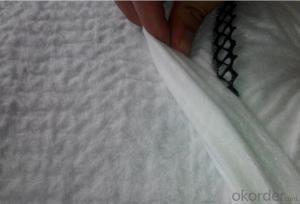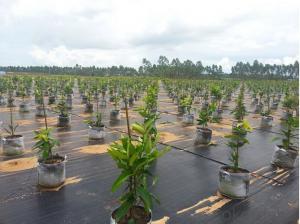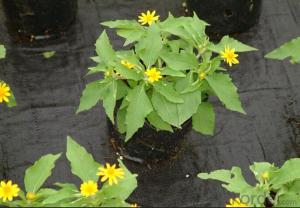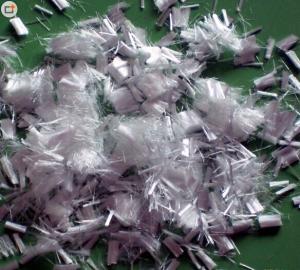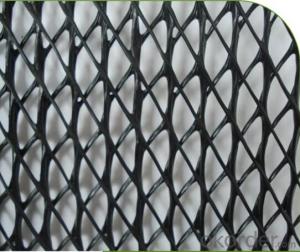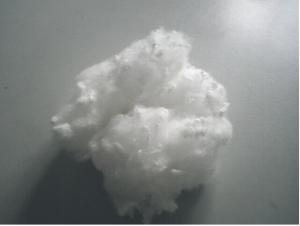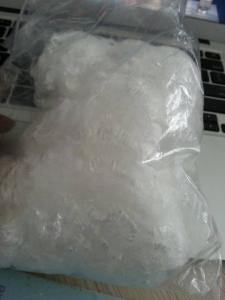Geonets/Geocomposite Drainage Liners for Erosion Control
- Loading Port:
- Qingdao
- Payment Terms:
- TT OR LC
- Min Order Qty:
- 2000 m²
- Supply Capability:
- 200000 m²/month
OKorder Service Pledge
OKorder Financial Service
You Might Also Like
Geonets/Geocomposite Drainage Liners for Erosion Control
Introduction
Geo-Net, also called drainage net, is a cost effective alternative to aggregate drains in containment systems. Geo-Nets take up less space than aggregate drains and can help to maximize volume in landfills and surface impoundments. Geo-Nets are commonly used between two geomembrane liners as part of a leak detection system. When placing Geo-Nets with geotextiles it is often effective to have the geotextile bonded to the Geo-Net in the factory. Geocomposites usually have a geotextile bonded to one, or to both sides of a Geo-Net. This creates a drainage structure that can be used between layers of geomembranes, and in many other unusual situations. The geotextile layers prevent the movement of soil fines into the Geo-Net drainage path that could lead to clogging and drainage failure.
Main features Geonet-Geotextile Drainage Geocomposite
1. Row water-borne strong (equivalent to one meter thick gravel drainage).
2. Tensile strength to be high .
3. Reduce geotextiles net core chance of embedded, maintain a long-term and stable drainage.
4. Long-term under great pressure and load (can bear about 3000Ka compression load)
5. Corrosion resistance, acid and alkali resistant, long service life.
6. Construction is convenient, shorten the construction period, lower cost.
8. Excellent drainage function, can bear long time high press road
9. High tensile and shear strength
10.Can bear more than 2000KPa compression load
11.anticompression capacity is much larger than common geonet for drainage.
Performance
1. Excellent drainage and sustain high compression loading
2. Highest tensile strength and shearing strength
3. Cut down ratio of geotextile into geonet and keep stable permeability in a long time
4. It can bear compression loading over 2000Kpa
5.Its compressive strength far exceeds general drainage geonet
Application
Using for drainage such as refuse landfill, roadbed & road surface, railway, tunnel, underground structure, retaining wall, garden, sports ground and so on.
Technical Data
Drainage network core | units | Specification | ||||
Unit weight | g/m2 | 750 | 1000 | 1300 | 1600 | |
Thickness | Mm | 5.0 | 6.0 | 7.0 | 7.6 | |
Hydraulic conductivity | m/s | kx10-4 | Kx10-4 | Kx10-4 | Kx10-4 | |
Elongation | % | 50 | 50 | 50 | 50 | |
Tensile strength (core netwaork) | kN/m | 8 | 10 | 12 | 14 | |
Geotextile | g/m2 | Heavier grades of geotextiles can be bonded to geonet on request | ||||
FAQ
1.How about the delivery time?
Lead time since receipt of 30% T/T deposit payment: 2-3 weeks. (Samples will be prepared within 3 days.)
2. What kind of payments does jenor support?
T/T, L/C, Cash are accepted.
3. What's are the MOQ?
We can according to your condition to set the MOQ. and we can provide you samples for quality inspection before the mass production.
4. Do you charge for the samples?
Accordeing to our company policy, the samples are free, we only charge the freight fee.
5. Can you produce according to customers' design?
Sure, we are professional manufacturer, OEM and ODM are both welcome.
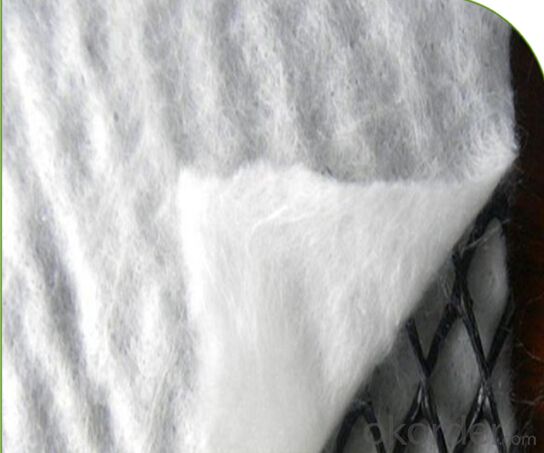
- Q:Can geosynthetics be used for pond lining?
- Yes, geosynthetics can be used for pond lining. Geosynthetics, such as geomembranes and geotextiles, are commonly used materials for lining ponds and other water containment structures. They provide excellent impermeability, durability, and resistance to various environmental conditions, making them an ideal choice for pond lining applications.
- Q:What is the function of geosynthetic drainage composites in road construction?
- Geosynthetic drainage composites serve the function of providing effective and efficient drainage in road construction. They help to manage water runoff by allowing excess water to be collected and directed away from the pavement structure, preventing water damage and prolonging the lifespan of the road. Additionally, these composites aid in stabilizing the subgrade and reducing the build-up of water pressure, ultimately enhancing the overall performance and durability of the road.
- Q:How do earthwork products contribute to groundwater pollution prevention?
- Earthwork products, such as geotextiles and geomembranes, play a crucial role in preventing groundwater pollution. These materials are used in various construction and engineering projects to create barriers and liners that prevent contaminants from seeping into the ground and reaching the groundwater. By effectively blocking the migration of pollutants, earthwork products help maintain the quality and integrity of groundwater sources, ensuring a safe and sustainable water supply for communities and ecosystems.
- Q:Are there any specific earthwork products available for shoreline protection?
- Yes, there are specific earthwork products available for shoreline protection. These products include geotextiles, geogrids, erosion control blankets, and revetment systems. They are designed to stabilize and protect shorelines from erosion caused by waves, currents, and storm events.
- Q:Can earthwork products be used for constructing walkways and pathways?
- Yes, earthwork products can be used for constructing walkways and pathways. These products, such as gravel, crushed stone, or sand, can provide a stable and durable base for walkways and pathways. Additionally, materials like pavers or bricks can be used in conjunction with earthwork products to create attractive and functional pathways.
- Q:Can earthwork products be used in sound barrier construction?
- Yes, earthwork products can be used in sound barrier construction. Earthwork products such as soil, sand, or gravel can be utilized as part of the foundation or filling materials for sound barriers. These materials provide stability and support to the structure while helping to reduce noise transmission by absorbing or deflecting sound waves.
- Q:How do geosynthetic products contribute to soil erosion prevention in vineyards?
- Geosynthetic products, such as geotextiles and geogrids, play a crucial role in preventing soil erosion in vineyards. These products are used to stabilize the soil and reinforce slopes, preventing them from eroding due to water runoff and other environmental factors. Geotextiles act as a barrier, reducing the velocity of water flow and preventing soil particles from being washed away. Geogrids provide structural support to the soil, increasing its stability and resistance to erosion. By incorporating geosynthetics in vineyard design and construction, soil erosion is effectively minimized, ensuring the longevity and sustainability of the vineyard ecosystem.
- Q:What are the different types of geotextile fabric installation methods?
- There are several different types of geotextile fabric installation methods, including direct placement, trench installation, and slope installation. Direct placement involves simply laying the fabric on the ground surface and securing it with staples or pins. Trench installation involves burying the fabric in a trench and then covering it with soil. Slope installation is used on steep slopes and involves securing the fabric to the slope using anchors or other methods to prevent erosion.
- Q:How can geosynthetic panels be used in bridge abutments?
- Geosynthetic panels can be used in bridge abutments to provide reinforcement and stability to the structure. These panels are typically made of high-strength materials such as geotextiles or geogrids, which are placed behind the abutment walls. By distributing the load and reducing lateral movement of the soil, geosynthetic panels help prevent soil erosion, settlement, and potential failure of the bridge abutments. Additionally, these panels can improve the overall performance and longevity of the bridge by enhancing its structural integrity and resistance to external forces.
- Q:How do earthwork products contribute to land reclamation projects?
- Earthwork products play a crucial role in land reclamation projects by providing essential materials for shaping the land and creating desired topography. These products, such as soil, sand, gravel, and rocks, are used to fill in low-lying areas, build up elevations, and stabilize the land. They help to reshape the terrain, create new landforms, and restore the natural balance of the reclaimed land. Additionally, earthwork products also aid in improving drainage systems and preventing erosion, ensuring the long-term sustainability of the reclaimed area.
1. Manufacturer Overview |
|
|---|---|
| Location | |
| Year Established | |
| Annual Output Value | |
| Main Markets | |
| Company Certifications | |
2. Manufacturer Certificates |
|
|---|---|
| a) Certification Name | |
| Range | |
| Reference | |
| Validity Period | |
3. Manufacturer Capability |
|
|---|---|
| a)Trade Capacity | |
| Nearest Port | |
| Export Percentage | |
| No.of Employees in Trade Department | |
| Language Spoken: | |
| b)Factory Information | |
| Factory Size: | |
| No. of Production Lines | |
| Contract Manufacturing | |
| Product Price Range | |
Send your message to us
Geonets/Geocomposite Drainage Liners for Erosion Control
- Loading Port:
- Qingdao
- Payment Terms:
- TT OR LC
- Min Order Qty:
- 2000 m²
- Supply Capability:
- 200000 m²/month
OKorder Service Pledge
OKorder Financial Service
Similar products
New products
Hot products
Hot Searches
Related keywords
